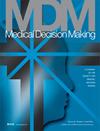General Population Mortality Adjustment in Survival Extrapolation of Cancer Trials: Exploring Plausibility and Implications for Cost-Effectiveness Analyses in HER2-Positive Breast Cancer in Sweden.
IF 3.1
3区 医学
Q2 HEALTH CARE SCIENCES & SERVICES
引用次数: 0
Abstract
BACKGROUND In economic evaluations of novel therapies, assessing lifetime effects based on trial data often necessitates survival extrapolation, with the choice of model affecting outcomes. The aim of this study was to assess accuracy and variability between alternative approaches to survival extrapolation. METHODS Data on HER2-positive breast cancer patients from the Swedish National Breast Cancer Register were used to fit standard parametric distribution (SPD) models and excess hazard (EH) models adjusting the survival projections based on general population mortality (GPM). Models were fitted using 6-y data for stage I and II, 4-y data for stage III, and 2-y data for stage IV cancer reflecting an early data cutoff while maintaining sufficient events for comparison of model estimates with actual long-term outcomes. We compared model projections of 15-y survival and restricted mean survival time (RMST) to 15-y registry data and explored the variability between models in extrapolations of long-term survival. RESULTS Among 11,224 patients compared with the observed registry 15-y RMST estimates across the disease stages, EH cure models provided the most accurate estimates in patients with stage I to III cancer, whereas EH models without cure most closely matched survival in patients with stage IV cancer, in which cure assumption was less plausible. The Akaike information criterion-averaged model projections varied as follows: -8.2% to +5.3% for SPD models, -4.9% to +5.2% for the EH model without a cure assumption, and -19.3% to -0.2% for the EH model with a cure assumption. EH models significantly reduced between-model variance in the predicted RMSTs over a 50-y time horizon compared with SPD models. CONCLUSIONS EH models may be considered as alternatives to SPD models to produce more accurate and plausible survival extrapolation that accounts for general population mortality. HIGHLIGHTS Excess hazard (EH) methods have been suggested as an approach to incorporate background mortality rates in economic evaluation using survival extrapolation.We highlight that EH models with or without a cure assumption can produce more accurate survival projections and significantly reduce between-model variability in comparison with standard parametric distribution models across cancer stages.EH models may be a preferred modeling method to reduce model uncertainty in health economic modeling since models that would otherwise have produced implausible extrapolations are constrained by the EH framework.Reduced uncertainty in economic evaluations will enhance the application of evidence-based health care decision making.癌症试验生存期外推中的普通人群死亡率调整:探索瑞典 HER2 阳性乳腺癌成本效益分析的合理性及其影响。
背景在对新型疗法进行经济评估时,根据试验数据评估终生疗效往往需要进行生存期外推,而模型的选择会影响结果。方法瑞典国家乳腺癌登记处的 HER2 阳性乳腺癌患者数据被用于拟合标准参数分布 (SPD) 模型和超额危险 (EH) 模型,根据一般人群死亡率 (GPM) 调整生存预测。模型的拟合使用了 I 期和 II 期的 6 年数据、III 期的 4 年数据以及 IV 期癌症的 2 年数据,这些数据反映了早期数据的截止日期,同时也保持了足够的事件数,以便将模型估计值与实际长期结果进行比较。我们将模型预测的 15 年生存期和限制性平均生存时间(RMST)与 15 年登记数据进行了比较,并探讨了不同模型在推断长期生存期方面的差异。结果在 11,224 名患者中,与观察到的各疾病分期登记 15 年 RMST 估计值相比,EH 治愈模型为 I 期至 III 期癌症患者提供了最准确的估计值,而无治愈的 EH 模型与 IV 期癌症患者的生存期最为匹配,在 IV 期癌症患者中,治愈假设不太可信。阿凯克信息准则平均模型预测值变化如下:SPD模型为-8.2%至+5.3%,无治愈假设的EH模型为-4.9%至+5.2%,有治愈假设的EH模型为-19.3%至-0.2%。与 SPD 模型相比,EH 模型大大降低了 50 年时间跨度内预测 RMST 的模型间差异。结论EH 模型可作为 SPD 模型的替代方法,以产生更准确、更合理的生存外推法,并考虑到一般人群的死亡率。我们强调,与癌症各期的标准参数分布模型相比,有无治愈假设的超常危害模型都能产生更准确的生存预测,并显著降低模型间的变异性。超常危害模型可能是降低健康经济建模中模型不确定性的首选建模方法,因为原本会产生难以置信的外推结果的模型受到了超常危害框架的限制。
本文章由计算机程序翻译,如有差异,请以英文原文为准。
求助全文
约1分钟内获得全文
求助全文
来源期刊

Medical Decision Making
医学-卫生保健
CiteScore
6.50
自引率
5.60%
发文量
146
审稿时长
6-12 weeks
期刊介绍:
Medical Decision Making offers rigorous and systematic approaches to decision making that are designed to improve the health and clinical care of individuals and to assist with health care policy development. Using the fundamentals of decision analysis and theory, economic evaluation, and evidence based quality assessment, Medical Decision Making presents both theoretical and practical statistical and modeling techniques and methods from a variety of disciplines.
 求助内容:
求助内容: 应助结果提醒方式:
应助结果提醒方式:


